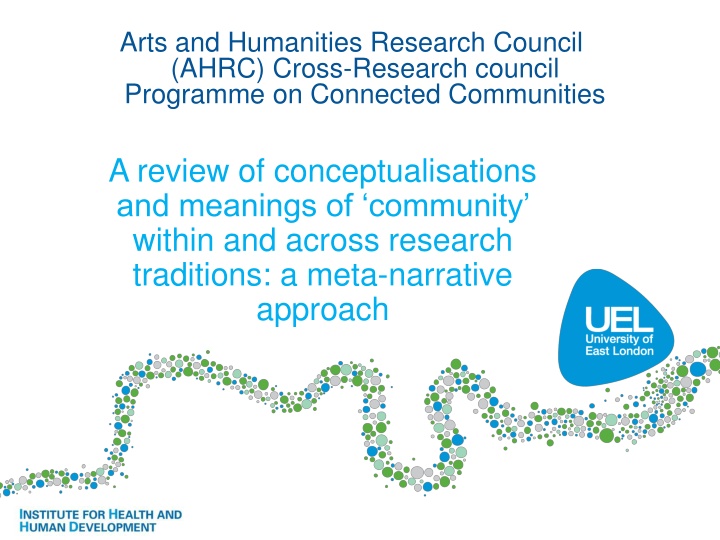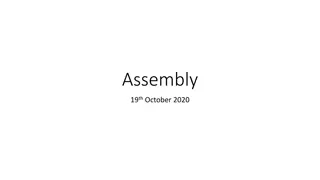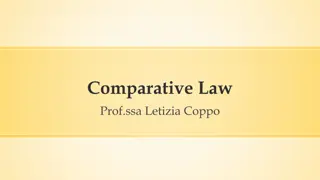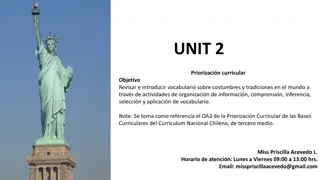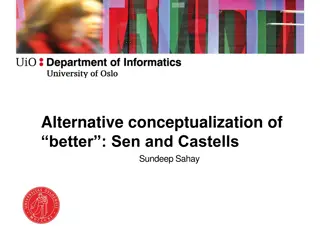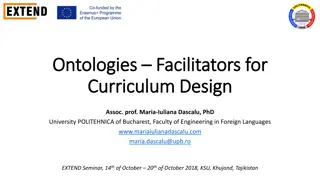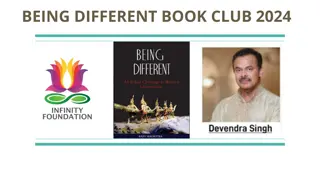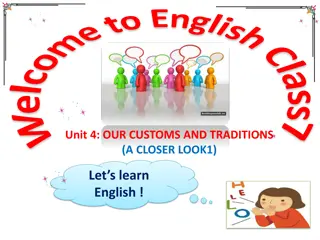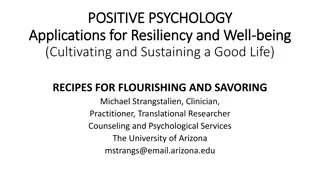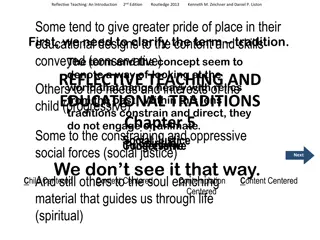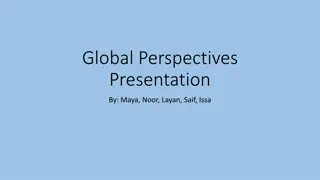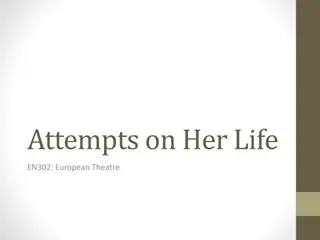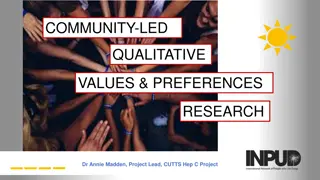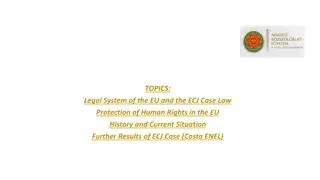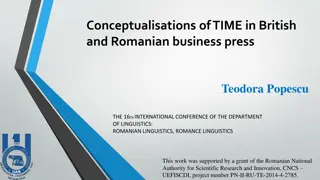The Evolution of Community Conceptualizations Across Research Traditions
This research review explores the changing conceptualizations of community over time within and across different research traditions, employing a meta-narrative approach. It delves into how community discourse has evolved, its implications for academic and policy development, and the methodologies used to analyze these changes.
Download Presentation

Please find below an Image/Link to download the presentation.
The content on the website is provided AS IS for your information and personal use only. It may not be sold, licensed, or shared on other websites without obtaining consent from the author.If you encounter any issues during the download, it is possible that the publisher has removed the file from their server.
You are allowed to download the files provided on this website for personal or commercial use, subject to the condition that they are used lawfully. All files are the property of their respective owners.
The content on the website is provided AS IS for your information and personal use only. It may not be sold, licensed, or shared on other websites without obtaining consent from the author.
E N D
Presentation Transcript
Arts and Humanities Research Council (AHRC) Cross-Research council Programme on Connected Communities A review of conceptualisations and meanings of community within and across research traditions: a meta-narrative approach
summary Objective of the research Methodology Explaining 10 meta-narratives Implications for further research
Main objective of the research Main research question is: How have conceptualisations of community changed over time within and across research traditions? Sub-research questions: What is known about discourses on communities within and across research disciplines? How have these changed over time? What are the implications for academic and policy development on the ground? Time period: Between April and October 2011
Diagram methodology Consultation events (policy, academic) Sources known to the research team Database Search sociology Mapping study for relevance Mapping & screening Identification of focus disciplines anthropology Identification of seminal studies political theory Within disciplines MNR sociology MNR MNR political theory anthropology Across disciplines Cross discipline meta-narrative synthesis N=10 (meta-narratives)
Meta-narrative one: commonality (anthropology) Community is a natural phenomenon, it concentrates on the study of indigenous communities distant others in villages, tribes, partly rooted in colonialism Community is Geographically defined groups of people Culturally and social homogenous the location of research rather than the object of research (Rapport & Overing, 2000). Important as starting point from where anthropological work developed
Meta-narrative two: The public sphere and formation of community This meta-narrative draws upon political theory and marks the beginning of community in a political sense. Aristotle focuses on values and principles that characterise how people associate rather than emphasising who constitutes the State This leads later scholars to consider forms of associations beyond the state.
Meta-narrative three: Transitionary perspectives on community - Start of community in sociology and anthropology (1880s) - Concern following industrial revolution (T nnies, Durkheim and Marx) - E.g. Transition from community to society (T nnies). Community is rural, moral stability, naturally developing, based on kinship and strong relationships, and inherently good; society is urban, individualistic, artificial, loose relationships based on convenience, and largely negative. - Major influences on community studies (Brint, 2001) and other meta-narratives See full size image
Meta-narrative four: Community in urban space - Combines sociological and anthropological work originating in the School of Chicago (from 1920s) - Urban space is the problem (e.g. Segregation, inequality) but also the solution (e.g. dynamism, innovation) - Community is not homogenous, but diverse, dense and transient (Wirth, 1938). They find the community in urban areas (urban villages, e.g. Gans, 1962) - Emphasis on space (concentric areas with central business districts and the inner city, zones of transition) - Mainly studies dynamics of groups, less interested in the perceptions of individuals
Meta-narrative five: Individualist versus communitarian approaches to community - Community attracts interest from both sides of political spectrum - Tension between liberalism (priority to the individual) esp. Rawls (1971) and communitarianism (priority to the group/community). - Various forms of communitarianism have emerged (e.g. Etzioni). Shared values, solidarity, attachments . Greater attention to cultural difference but at the cost of social equality (Delanty, 2003) - However, communities are increasingly virtual, fluid in membership, superdiverse, insecure, transient
Meta-narrative six: Community studies -Primary aim is to study all types of interactions that take place outside the household (Crow and Allan, 1994) - Critique to the School of Chicago which over-emphasised space and dynamics of large groups (from 1960s) See full size image -It draws upon T nnies in terms of its emphasis on kinship (Brint, 2001) but it has substantially developed since (e.g. Network analysis) -Concerned with building a conceptualisation of community from empirical work driven by case study research and participant observation (Bell and Newby, 1971)
Meta-narrative seven: Generating or mobilising community Community is a social construction, it is an ideal to be aspired to through collective action. it does not exist in nature but needs to be built (Marx) http://t1.gstatic.com/images?q=tbn:ANd9GcSnpuEoTNeDYfE81GGPeHFeHIrji_qVkU2Lzpn9fpUrIAc2iW9gLu08tRI Providing voice to marginalised groups around common concerns to contrast both market and state e.g. community development tradition
Meta-narrative eight: symbolic approaches to community (from 1980s) -Communities are symbolic constructs that emerges from a perception of boundary which separates one group from another (Cohen, 1985) - community is a relational concept. It is determined by defining who is in and who is out. -Communities are a way for people to make meanings of reality See full size image -Community are also imagined in the sense That people do not need f2f interaction. Communities are built around sentiments which are generated through people sharing and reading the same documents and thus generating a common understanding (Anderson, 1983)
Meta-narrative nine: market economy perspectives on community Trust relations, reciprocity which are assumed to flow from communities can create social capital which positively influences both market economies and democracy (Fukuyama 1996; Putnam, 1993) (e.g. Bonding and bridging social capital) Communities in this sense are promoted as they bring a range of advantages primarily economic and of civic participation This recognises that social relations Influence economic and political structures
Meta-narrative ten: Globally oriented approaches - Globalisation, technological and transport changes, transience can be seen as a powerful critique of localities and community as place (e.g. virtual communities). See full size image - Place is replaced with flows (Castells, 1996; Urry, 2000). E.g. globalisation has both negative and positive impact on communities - More choice to belong or not belong to a community (Fluidity of membership) -Weak ties as opposed to strong ties (thin and thick) (Turner, 2001). - More imagined communities (less f2f contact) but Diluted messages?
Conclusions - emphasis changes over time (space, individual versus collective, connections, networks) -A marked shift in the 1980s with symbolism, imaginings, and sentiments. A much stronger focus on the individual (belonging, affect?). - further shift away from space, towards flows. Thin communities? Implications for future research: - need to study how people negotiate their simultaneous belonging to several communities and how these influence each other.
Policy implications Consultation sessions and review of literature highlighted a gap between the conceptualisations of community and policy practice -On the one hand, in policy (e.g. Big Society) what is meant by community is often space based and linked to traditional ideas of community - On the other, many conceptualisations of community and some extremely difficult to apply into practice -However, there is a need to bridge this gap. Perhaps one way to do this, is to examine in detail empirical research on community examining the contribution of different meta- narratives and bring in other fields (e.g. Community psychology)
Policy implications cont This work could be used to help decision-makers to think about what assumptions they are making about communities and expose them to alternative ways to understanding communities.
